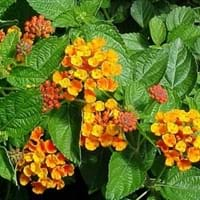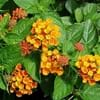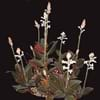Life Span
Perennial
Perennial
Type
Tender Perennial
Perennial
Origin
Hybrid origin, South America
Southeastern United States, North-Central United States, Central United States, South-Central United States, Southwestern United States, Texas, Canada, Mexico
Types
it is a type of lantana
Not Available
Habitat
agricultural areas, Coastal Regions, Forest margins, Grassland, riparian zones, secondary forest
Dry areas, Prairies, Rocky areas, rocky outcrops
USDA Hardiness Zone
10-11
3-10
Sunset Zone
H1, H2, 1a, 1b, 2a, 2b, 3a, 3b, 4, 5, 6, 7, 8, 9, 10, 11, 12, 13, 14, 15, 16, 17, 18, 19, 20, 21, 22, 23, 24
A1, A2, A3, H1, H2, 1a, 1b, 2a, 2b, 3a, 3b, 4, 5, 6, 7, 8, 9, 10, 11, 12, 13, 14, 15, 16, 17, 18, 19, 20, 21, 22, 23, 24
Habit
Spreading
Upright/Erect
Flower Color
Yellow, Red, Coral
Yellow, Purple, Burgundy, Light Green, Brown
Flower Color Modifier
Bicolor
Bicolor
Fruit Color
Blue, Black
Brown
Leaf Color in Spring
Dark Green
Light Green, Gray Green
Leaf Color in Summer
Dark Green
Light Green, Gray Green
Leaf Color in Fall
Dark Green
Light Green, Gray Green
Leaf Color in Winter
Light Green
Light Green
Leaf Shape
Ovate
Subulate
Plant Season
Spring, Summer, Fall, Winter
Summer
Sunlight
Full Sun, Partial Sun
Full Sun
Type of Soil
Clay, Loam, Sand
Loam, Sand
The pH of Soil
Acidic, Neutral, Alkaline
Neutral
Soil Drainage
Well drained
Well drained
Bloom Time
Indeterminate
Late Spring, Early Summer, Summer, Late Summer
Tolerances
Drought
Drought
Where to Plant?
Container, Ground, Pot
Ground
How to Plant?
Seedlings
Seedlings
Plant Maintenance
Medium
Medium
Watering Requirements
occasional watering once established, Requires watering in the growing season
Average Water Needs, Water in morning to avoid prompting diseases
In Summer
Lots of watering
Lots of watering
In Spring
Moderate
Moderate
In Winter
Average Water
Average Water
Soil pH
Acidic, Neutral, Alkaline
Neutral
Soil Type
Clay, Loam, Sand
Loam, Sand
Soil Drainage Capacity
Well drained
Well drained
Sun Exposure
Full Sun, Partial Sun
Full Sun
Pruning
Remove damaged leaves, Remove dead branches, Remove dead leaves
Cut or pinch the stems, Pinch Tips, Remove damaged leaves, Remove dead branches, Remove dead flowers, Remove dead leaves, Remove dead or diseased plant parts, Remove deadheads
Fertilizers
All-Purpose Liquid Fertilizer
All-Purpose Liquid Fertilizer, Apply N-P-K
Pests and Diseases
Red blotch
Pests and diseases free, Red blotch
Plant Tolerance
Drought
Drought, Dry Conditions, Dry soil, Full Sun
Flower Petal Number
Single
Single
Foliage Texture
Medium
Fine
Foliage Sheen
Matte
Matte
Attracts
Bees, Butterflies
Birds, Butterflies
Aesthetic Uses
Cottage Garden, Showy Purposes
Borders
Beauty Benefits
Not Available
Not Available
Environmental Uses
Provides ground cover
Air purification
Medicinal Uses
No Medicinal Use
Analgesic
Part of Plant Used
Whole plant
Flowers
Other Uses
Used as Ornamental plant
Can be made into a herbal tea, Used in making tea
Used As Indoor Plant
No
No
Used As Outdoor Plant
Yes
Yes
Garden Design
Bedding Plant, Container, Feature Plant, Foundation, Mixed Border, Topiary / Bonsai / Espalier, Tropical
Container, Cutflower, Mixed Border, Wildflower
Botanical Name
LANTANA camara 'Radiation'
RATIBIDA columnifera
Common Name
Lantana, Radiation Lantana
Mexican Hat
In Hindi
Radiation Lantana
Mexican Hat
In German
Strahlen Lantana
Mexican Hat
In French
rayonnement Lantana
Mexican Hat
In Spanish
La radiación Lantana
mexican Hat
In Greek
ακτινοβολία Lantana
Mexican Hat
In Portuguese
radiação Lantana
Mexican Hat
In Polish
promieniowanie Lantana
Mexican Hat
In Latin
radiation Lantana
Mexicanus Hat
Phylum
Not Available
Tracheophyta
Class
Not Available
Magnoliopsida
Family
Verbenaceae
Asteraceae
Clade
Angiosperms, Asterids, Eudicots
Angiosperms, Asterids, Eudicots
Tribe
Not Available
Not Available
Subfamily
Not Available
Not Available
Number of Species
Not Available
Not Available
Season and Care of Radiation Lantana and Mexican Hat
Season and care of Radiation Lantana and Mexican Hat is important to know. While considering everything about Radiation Lantana and Mexican Hat Care, growing season is an essential factor. Radiation Lantana season is Spring, Summer, Fall and Winter and Mexican Hat season is Spring, Summer, Fall and Winter. The type of soil for Radiation Lantana is Clay, Loam, Sand and for Mexican Hat is Loam, Sand while the PH of soil for Radiation Lantana is Acidic, Neutral, Alkaline and for Mexican Hat is Neutral.
Radiation Lantana and Mexican Hat Physical Information
Radiation Lantana and Mexican Hat physical information is very important for comparison. Radiation Lantana height is 90.00 cm and width 90.00 cm whereas Mexican Hat height is 30.00 cm and width 30.50 cm. The color specification of Radiation Lantana and Mexican Hat are as follows:
Radiation Lantana flower color: Yellow, Red and Coral
Radiation Lantana leaf color: Dark Green
Mexican Hat flower color: Yellow, Purple, Burgundy, Light Green and Brown
- Mexican Hat leaf color: Light Green and Gray Green
Care of Radiation Lantana and Mexican Hat
Care of Radiation Lantana and Mexican Hat include pruning, fertilizers, watering etc. Radiation Lantana pruning is done Remove damaged leaves, Remove dead branches and Remove dead leaves and Mexican Hat pruning is done Cut or pinch the stems, Pinch Tips, Remove damaged leaves, Remove dead branches, Remove dead flowers, Remove dead leaves, Remove dead or diseased plant parts and Remove deadheads. In summer Radiation Lantana needs Lots of watering and in winter, it needs Average Water. Whereas, in summer Mexican Hat needs Lots of watering and in winter, it needs Average Water.




